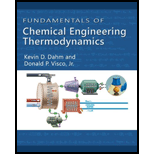
(A)
Interpretation:
The efficiency of a Carnot heat engine
Concept Introduction:
The expression to calculate the efficiency of a Carnot heat engine
Here, temperature of a low temperature heat reservoir is
(A)
Explanation of Solution
Given information:
High temperature reservoir is
Low temperature reservoir is
Calculate the efficiency of a Carnot heat engine
Substitute
Thus, the efficiency of a Carnot heat engine
(B)
Interpretation:
The efficiency of a Carnot heat engine
Concept Introduction:
The expression to calculate the efficiency of a Carnot heat engine
Here, temperature of a low temperature heat reservoir is
(B)
Explanation of Solution
Given information:
High temperature reservoir is
Low temperature reservoir is
Calculate the efficiency of a Carnot heat engine
Substitute
Thus, the efficiency of a Carnot heat engine
(C)
Interpretation:
The rate at which entropy the entropy of the universe is increased by the processes in the boiler and condenser.
Concept Introduction:
The steady state energy balance equation for the boiler.
Here, time taken is
Write the expression to calculate the net change in specific enthalpy
Here, constant pressure heat capacity of liquid is
Write the expression to calculate the change in entropy of a heat reservoir
Here, change in temperature is
Write the steady state entropy balance equation for boiler.
Here, total mass is
The formula to calculate the net entropy
Here, final entropy is
The expression to calculate the rate of heat
Here, enthalpy of formation is
The expression to calculate the change in specific entropy
The expression to calculate the rate at which entropy is generated within the boundaries of the system.
(C)
Explanation of Solution
Calculate the heat transfer of the boiler using the steady state equation.
Rewrite the steady state equation (3) by neglecting the work done, potential energy, and kinetic energy.
Calculate the net change in specific enthalpy
Substitute
Substitute
Calculate the change in entropy of a heat reservoir
Substitute
Calculate the entropy changes for the system that includes both the heat reservoir and the boiler.
Substitute
Write the internal energy equation.
Here, change in work added to the system through expansion or contraction of the system is
Since constant pressure heat capacity
Here, volume is
Substitute
Substitute
Calculate the net specific entropy
Here, enthalpy of vaporization is
Substitute
Substitute
Thus, the rate at which entropy is generated within the boiler is
Calculate the rate of heat
Substitute
Calculate the rate of entropy increase
Substitute
Calculate the change in specific entropy
Substitute
Calculate the rate at which entropy is generated within the boundaries of the system.
Substitute
Thus, the rate at which entropy is generated within the condenser is
Want to see more full solutions like this?
Chapter 4 Solutions
Fundamentals of Chemical Engineering Thermodynamics (MindTap Course List)
 Introduction to Chemical Engineering Thermodynami...Chemical EngineeringISBN:9781259696527Author:J.M. Smith Termodinamica en ingenieria quimica, Hendrick C Van Ness, Michael Abbott, Mark SwihartPublisher:McGraw-Hill Education
Introduction to Chemical Engineering Thermodynami...Chemical EngineeringISBN:9781259696527Author:J.M. Smith Termodinamica en ingenieria quimica, Hendrick C Van Ness, Michael Abbott, Mark SwihartPublisher:McGraw-Hill Education Elementary Principles of Chemical Processes, Bind...Chemical EngineeringISBN:9781118431221Author:Richard M. Felder, Ronald W. Rousseau, Lisa G. BullardPublisher:WILEY
Elementary Principles of Chemical Processes, Bind...Chemical EngineeringISBN:9781118431221Author:Richard M. Felder, Ronald W. Rousseau, Lisa G. BullardPublisher:WILEY Elements of Chemical Reaction Engineering (5th Ed...Chemical EngineeringISBN:9780133887518Author:H. Scott FoglerPublisher:Prentice Hall
Elements of Chemical Reaction Engineering (5th Ed...Chemical EngineeringISBN:9780133887518Author:H. Scott FoglerPublisher:Prentice Hall
 Industrial Plastics: Theory and ApplicationsChemical EngineeringISBN:9781285061238Author:Lokensgard, ErikPublisher:Delmar Cengage Learning
Industrial Plastics: Theory and ApplicationsChemical EngineeringISBN:9781285061238Author:Lokensgard, ErikPublisher:Delmar Cengage Learning Unit Operations of Chemical EngineeringChemical EngineeringISBN:9780072848236Author:Warren McCabe, Julian C. Smith, Peter HarriottPublisher:McGraw-Hill Companies, The
Unit Operations of Chemical EngineeringChemical EngineeringISBN:9780072848236Author:Warren McCabe, Julian C. Smith, Peter HarriottPublisher:McGraw-Hill Companies, The





